Kilmarnock Tree Surgeon Scotland: Adding structure, substance and style to what can at times be a 2 dimensional area, trees are an important feature of gardens and properties in Kilmarnock. However, when poorly maintained or affected by severe weather conditions like high winds or flooding, trees can be a bit of a problem. Seeking the advice of a skilled tree surgeon in Kilmarnock, is the best option when work needs to be done on your trees.
Employing a non-qualified person for tree work or attempting to do it on your own, could harm your trees, cause damage to property, or even be life threatening. However, tree work is not a safe undertaking, even for specialist tree surgeons, who are well acquainted with all the dangers. On average there are a hundred and forty serious injuries and three deaths per year within the profession, making it one of the most dangerous jobs in Britain and definitely not for novices to try.
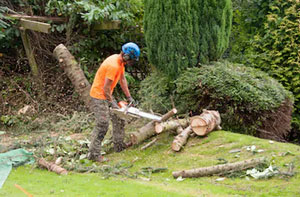
A damaged or neglected tree can also pose a risk to life, with around 5 people a year being killed by falling trees and branches in the UK. You may well be liable for any compensation to a third-party as a consequence of your actions, if you hire somebody to conduct tree work and an injury occurs, or property is damaged. The above are just some of the reasons why it is essential to use an accredited tree surgeon to undertake the work on your trees in Kilmarnock. (All figures are from HSE).
A decent Kilmarnock tree surgeon will likely be an approved member of one or both of the 2 main trade bodies. Both the AA (Arboricultural Association) and the ISA (International Society of Arboriculture) offers a website where you can check up on the membership and professional standing of any tree surgeon in Kilmarnock. To determine whether any specific local tree surgeon has ARB Approved Contractor status and has membership of either of these associations, you can do a search on this page.
If a problem arises during or after any work has been carried out you're able to communicate with these professional organisations for assistance in arbitration and for guidance and help at any point.
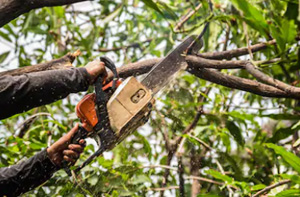
If someone offers you a quote for any tree work and you cannot find them on this directory list, you should courteously decline their offer of work and continue your search for an approved contractor. You should try to get a minimum of three different quotations from various companies in the Kilmarnock area as soon as you've reassured yourself of their professional qualifications and memberships. Because of the risks involved in the work, you should ask the below questions, making it abundantly clear that you need a response:
- Can I assess the standard of your work by contacting a person you have recently worked for? Doing an independent check on any recent work is always advisable.
- Precisely what level of insurance cover have you got? Your tree surgeon should be able to produce an insurance certificate covering at the least £5 Million public liability, as recommended by the ISA and AA.
- Do you have a NPTC/LANTRA certificate for the use of a chainsaw, and documentary proof of your professional memberships and qualifications? The NPTC/LANTRA is a required certificate in law for any tree surgeon/operative who uses a chainsaw. Certificates and National Diplomas in Arboriculture are qualifications that might be held by a certified Kilmarnock tree surgeon.
- Do you offer written quotations? Verbal quotes alone aren't acceptable. Always get a written quote.
The written quote that you are given should include clear and accurate specifics of the proposed tree work. Who is responsible for the removal of waste, tree branches and stumps should be stated, as should specifics of any trees which might be protected in law, and the necessary steps to get permission to carry out work on them. You should also ensure that VAT is included on the quote. You've got a responsibility to employ only qualified tradespeople to work on your trees and property, and it is important to understand that fact. This is outlined by the "Common law duty of care responsibilities under the Occupier's Liability Acts of 1957 and 1984."
PRIOR TO WORK COMMENCING - Your preferred Kilmarnock tree surgeon should make enquiries into the possibility of any trees being protected in your area and take the appropriate steps to make sure that any work can get the go-ahead from the local authorities. To ensure public safety, even protected trees need to be maintained in order to cut back old or dying wood, therefore discovering that a tree is protected doesn't suggest that you're unable to carry out essential work.
At least six weeks written notice must be given to the Local Planning Authority before any tree work can be performed, if your property in Kilmarnock is inside a designated conservation area. However, tree trunks of less than 75 millimetres in diameter when measured at 1.5m from ground level are exempt from this requirement. It is also not necessary to give written notice if a protected tree's branches need thinning or pruning simply to encourage and sustain growth.
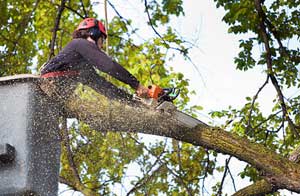
After fully assessing the health of the trees on your property, your chosen Kilmarnock tree surgeon will determine the necessary treatments and how the best outcome can be safely achieved. Where there is any potential for falling debris, a full risk assessment will have to be done on your property, public areas, and sections of neighbouring properties that might be impacted. This stage will also determine the number of workers required and the level of protection needed. This is both PPE and other safety precautions to keep property and the general public safe from damage or harm.
ON THE DAY OF WORK - Safety measures and barriers should be put in place before any tree felling, climbing or cutting of branches is started, to keep unauthorised persons away from the area where work is going on. When there's the possibility of branches and debris falling onto a public highway, it may be necessary to briefly halt the traffic.
Varying degrees of protection will be needed by the tree surgeon subject to what tree work needs to be completed. At the bare minimum when doing work with a chainsaw they need to be wearing protective clothing to avoid injuring the torso, hands and legs. Head and eye protection, and hi-vis clothing, must be worn by all workers involved in the operation.
Extra operatives will generally be needed to assist in the safe removal of high branches and large sections of tree trunk, particularly if any working at height is involved, and where ladders and associated climbing equipment is being deployed. For taking waste materials away from the work area, a truck or skip will be stationed as close as possible to the area. This requirement for easy access is as good a reason as any for informing your nearby neighbours of the work.
AFTER COMPLETION OF WORK - All of the waste and branches will be taken away and the whole area cleared of any debris, when all the work has been completed. A certificate of work will then be created by your tree surgeon, particularly when the trees are protected, which can be signed off and a copy handed to you. If any public spaces needed safety measures, this protection can be taken away and pathways and roads will be re-opened to the public.
If you have any complaints about the completed work, you should get them put right immediately by firstly speaking to your tree surgeon. If your tree surgeon is an approved member of a professional trade body, and there's any further dispute, you can get guidance and help from the International Society of Arboriculture or the Arboricultural Association so as to come to an acceptable solution.
Local Kilmarnock tree surgery services will most likely have the postcode KA1 and the telephone dialling code 01563. They will work in Kilmarnock itself, along with nearby areas like Darvel, Hurlford, Mauchline, Troon, Dalry, Galston, Dundonald, Stewarton, Girdle Toll, Tarbolton, Crosshouse, Knockentiber, Dreghorn, Irvine, Dunlop, Saltcoats, Kilwinning, Newmilns, Ayr, Kilmaurs, and these postcodes: KA1 1DG, KA1 1QE, KA1 1HW, KA1 1BS, KA1 1LN, KA1 2AB, KA1 1BA, KA1 2BX, KA1 1LL, KA1 1TJ.
For this sort of service it's unquestionably a good idea to bring in an approved tree surgeon. Kilmarnock business and home owners can benefit greatly from the expertise that a fully trained professional can offer.
Dutch Elm Disease
While Dutch Elm Disease (Ophiostoma novo-ulmi) is not quite the issue it once was, during the past fifty years or so it has wiped out tens of millons of elm trees throughout the United Kingdom. Spread by the elm bark beetle (especially the Scolytus genus) and caused by the Ophiostoma novo-ulmi fungus, Dutch Elm Disease was unintentionally introduced into the United Kingdom from North America (Canada) in the late 1960s.
After arriving, it swiftly spread through the nationwide movement of elm products like bark mulch, saplings, elm crates, and firewood logs with the bark on. This awful disease didn't just impact elms in Great Britain, but also devastated tree stocks in continental Europe and North America. While the origins of DED are as yet unproven, the suspicion is that it first originated from Asia (probably Japan).
Dutch Elm Disease usually first materializes in early summer, and the main signs are:
- Clusters of leaves that turn yellow, wilt and fall.
- New shoots dying back from the tips.
- A "shepherd's crook" reaction on affected twigs.
- Twigs with spots or rings in cross-section.
Due to disease and the felling of infected, dead and dying trees, there are not many large elms remaining in the UK's countryside, and thus the spread has slowed and the elm bark beetle's habitat essentially decimated. There's currently an ongoing project for the propagation of young saplings which are so far resistant to DED.
If you have elms on your property in Kilmarnock, and are suspicious that they might be affected by Dutch Elm Disease, you should contact your local tree surgeon for advice, or ask for a diagnosis from the Tree Health Diagnostic & Advisory Service.
Ash Dieback
Expected to devastate approximately 80 percent of the current UK ash tree population, over the next few years, ash dieback is a destructive fungal disease of ash trees that was first reported in Great Britain in 2012. Following the tragedy of Dutch Elm Disease, which killed off the United Kingdom's elm trees, ash dieback is almost certain to have huge repercussions for our beloved countryside.
Ash dieback has a particularly disastrous effect on the native Fraxinus excelsior (common ash), British Fraxinus excelsior (common ash), although it affects all trees of the Fraxinus genus, which have varying degrees of tolerance. Thought to have originally come from eastern Asia where the native species of ash (the Manchurian ash and the Chinese ash) were more resistant, the fungus which causes the disease is called Hymenoscyphus fraxineus, and it blocks its vascular (water transport) systems, causing it to die.
Already present in most regions of the United Kingdom, ash dieback (or chalara ash dieback) is dispersed by wind blown spores produced by the fruiting bodies of the fungus, and can travel for many miles.
The unmistakeable symptoms of ash dieback are:
- Dying shoots and leaves which are visible during the summertime.
- New growth appears from previously dormant buds (epicormic growth).
- Leaves that wilt, turn black in colour and fall prematurely.
- Dark brown lesions (often diamond shaped) form where branches meet the trunk, and the inner bark under the lesions looks brownish grey.
- Dark patches on leaves during mid to late summer.
Sometimes ash trees are able to fend off initial infections, but as the disease returns year-on-year, they ultimately succumb. At this time there is no clear method for stopping the spread of aash dieback, and there's no cure or effective treatment.
If you think you have spotted a case of ash dieback on your property in Kilmarnock, or someplace else in the local community, you can report it to the "Tree Alert Service" provided by the Forestry Commission, although chalara ash dieback is so common throughout Great Britain that they're only really interested to know about cases found in locations not affected previously. You should however get in touch with a local tree surgeon, who can offer advice and guidance on how to proceed.
Trees of the genus Fraxinus are affected by ash dieback.
Tree Surveys Kilmarnock
There are various reasons why you might need a tree survey, and the most commonplace is for property extension or land development. If you are clearing some land to make room for an extension to an existing property or a brand new house in Kilmarnock, for instance, you will need to carry out a professional tree survey to British Standards BS5837 if there are trees growing on that land. Kilmarnock tree surveys on both private and public property, must be handled by a certified tree surveyor or tree surgeon.
For a defined area, a whole bunch of information will be produced about all of the trees within it. For instance:
- The number of trees (those of over 75mm diameter 1.5m from the ground).
- The existence of any Tree Preservation Orders (TPOs).
- The height of each tree.
- The age of the trees (i.e. young, semi-mature, mature, over-mature and veteran).
- The diameter of each tree (measured 1.5m above ground level).
- Tree management recommendations.
- The branch spread to the South, North, West and East.
- A unique tree reference number for every tree.
- The species of trees on the site (either scientific or common).
- The physiological and structural health of the trees.
- The predicted life expectancy of the trees.
If you are doing work on an existing home in Kilmarnock but you're not increasing the footprint of the property and aren't modifying the access points or service lines, a tree survey will most likely not be required. (Tags: Tree Survey Kilmarnock, Tree Surveyors Kilmarnock, Tree Surveys Kilmarnock, Kilmarnock Tree Surveys).
Storm Damage Kilmarnock
While we are all aware of the extreme power of Mother Nature, larger trees seem strong, sturdy and able to withstand more or less any eventuality. Actually certain varieties of tree can live for hundreds (even thousands) of years and happily do so without any issues.
Severe weather conditions can however cause considerable damage, and in addition to the danger of falling limbs and branches, trees can even topple over completely in certain circumstances. The primary enemy of, and danger to trees, is high winds, and with escalating frequency of violent storms and extreme weather events this type of damage has become more and more commonplace in Kilmarnock. Flooding or prolonged periods of rainfall can cause soil to become saturated, which can cause further problems for trees, as can heavy snowfall during wintertime.
It's advisable to get a qualified Kilmarnock tree surgeon to examine your trees to reduce the likelihood of issues with your trees in severe weather conditions, they'll trim and remove any dead or excessively long branches that might be a problem.
It's also recommended to fit bigger trees with copper conductors, lightning rods, or other protection systems, to prevent them getting struck by lightning, and to protect nearby property and buildings which might be susceptible to side-flashes ("arcs"). A lightning strike can easily kill a tree, or severely weaken it, making it more vulnerable to pest attacks and disease. You might not believe that lightning strikes are all that common, yet in the UK alone there are around three hundred thousand lightning strikes recorded annually.
To protect your trees from being damaged by storms and minimise the chances of severe consequences should an unsound tree crash down as a result of bad weather, ask your local Kilmarnock tree surgery firm what they can do.
Woodland Clearance Kilmarnock
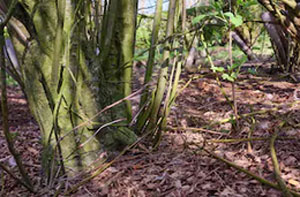
The clearance of woodlands in the Kilmarnock area is a sophisticated process that can be impacted by various regulations and restrictions. To make sure that all applicable permits are gathered, land covenants and restrictions are enforced, and that all strategies for clearing the area are environmentally sound, an experienced Kilmarnock tree surgeon should be recruited to supervise and complete the project.
A good tree surgeon will check if there are any ecological constraints, special planning permissions or felling restrictions by conducting a full site survey and having discussions with local authorities. Mitigation procedures may have to be used if there's protected animal species or plants in the area; this could involve replanting of trees and relocation of animals, such as bats or lizards to another protected site.
The specialist mulching, chipping and felling equipment that's employed in woodland clearance means that it is usually much more efficient and cost effective to bring in a specialist tree surgeon to execute the project. (Tags: Woodland Clearance Kilmarnock, Woodland Management Kilmarnock, Woodland Preservation Kilmarnock, Woodland Clearances Kilmarnock).
Tree Surgery Tasks Kilmarnock

Kilmarnock tree surgeons will likely help with domestic tree care, brush cutting, crown lifting, tree waste removal, pest control Kilmarnock, landscape clearing, arboriculture Kilmarnock, tree replanting, waste removal in Kilmarnock, formative pruning Kilmarnock, tree maintenance, tree lopping, stump removal, eco plug treatments, shrub maintenance Kilmarnock, tree pollarding Kilmarnock, tree felling, site clearance, tree cutting, crown thinning, woodland management, tree shaping, stump treatment, tree reduction, forestry management, the protection of trees from grazing in Kilmarnock, emergency tree removal Kilmarnock, tree care Kilmarnock, damage restoration, landscaping and other tree surgeon services in Kilmarnock, Scotland. These are just a small portion of the tasks that are accomplished by a tree surgeon. Kilmarnock specialists will be delighted to keep you abreast of their full range of services.
Tree Surgeons Nearby
Also find: Crosshouse tree surgeon, Dundonald tree surgeon, Knockentiber tree surgeon, Hurlford tree surgeon, Girdle Toll tree surgeon, Darvel tree surgeon, Tarbolton tree surgeon, Newmilns tree surgeon, Dunlop tree surgeon, Dreghorn tree surgeon, Saltcoats tree surgeon, Kilmaurs tree surgeon, Mauchline tree surgeon and more. All of these places are catered for by tree surgeons. Property owners in the area can obtain tree surgery price quotes by going here.
Tree Care Services Kilmarnock
- Kilmarnock Wood Chipping
- Kilmarnock Dead Wooding
- Kilmarnock Root Removal
- Kilmarnock Hedge Planting
- Kilmarnock Tree Replanting
- Kilmarnock Shrub Maintenance
- Kilmarnock Crown Thinning
- Kilmarnock Tree Reduction
- Kilmarnock Tree Watering
- Kilmarnock Air-Spading
- Kilmarnock Tree Reshaping
- Kilmarnock Stump Treatment
- Kilmarnock Tree Pruning
- Kilmarnock Root Grinding
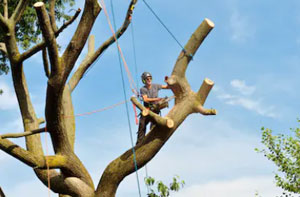 Tree Surgeon Kilmarnock
Tree Surgeon Kilmarnock Tree Surgeons Kilmarnock
Tree Surgeons Kilmarnock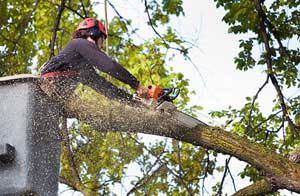 Tree Surgery Kilmarnock
Tree Surgery KilmarnockTo read local information on Kilmarnock, Scotland look here
Tree Surgery KA1 area, phone code 01563.
01563 - Stump Removal Kilmarnock - Tree Care Kilmarnock - Root Removal Kilmarnock - Vegetation Control Scotland - Tree Management Kilmarnock - Crown Reduction Kilmarnock - KA1 - Tree Surgery Kilmarnock




